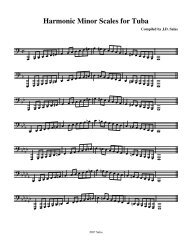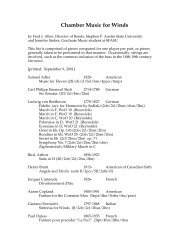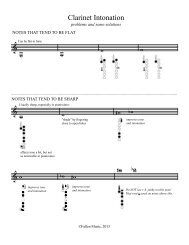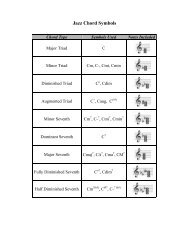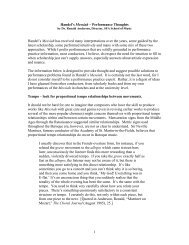Trombone Rep - History of the Trombone - Timeline 1 (EatonMensch ...
Trombone Rep - History of the Trombone - Timeline 1 (EatonMensch ...
Trombone Rep - History of the Trombone - Timeline 1 (EatonMensch ...
Create successful ePaper yourself
Turn your PDF publications into a flip-book with our unique Google optimized e-Paper software.
<strong>History</strong> <strong>of</strong> <strong>the</strong> <strong>Trombone</strong><br />
P. 11<br />
Date Information Citation<br />
ca. 1685 A.D.<br />
Talbot's description <strong>of</strong> <strong>the</strong> English Flat Trumpet: "'The mouthpiece stands obliquely towards<br />
<strong>the</strong> right. The rear bow is by <strong>the</strong> left ear and by it [<strong>the</strong>re is no mention <strong>of</strong> a stay] you draw out<br />
<strong>the</strong> slide, <strong>of</strong> which one leg reaches inside <strong>the</strong> bell branch as far as <strong>the</strong> boss; <strong>the</strong> o<strong>the</strong>r reaches<br />
outside <strong>the</strong> lower branch as far as <strong>the</strong> front bow and measures 58 cm. from <strong>the</strong> end <strong>of</strong> <strong>the</strong> rear<br />
bow ferrule."<br />
Baines p. 181<br />
1685 A.D. "Legrenzi's orchestra <strong>of</strong> St. Mark's in 1685 included three trombones." Carse p. 18<br />
1687 A.D.<br />
1687 A.D.<br />
1697 A.D.<br />
end <strong>of</strong> <strong>the</strong><br />
1600s A.D.<br />
"Daniel Speer's Grund-richtiger…Unterricht der musicalischen Kunst represents <strong>the</strong><br />
culmination <strong>of</strong> Baroque thought about <strong>the</strong> trombone."<br />
Daniel Speer's Art <strong>of</strong> Music has an article about <strong>the</strong> trombone that is technical and covers<br />
such things as <strong>the</strong> length <strong>of</strong> <strong>the</strong> instrument, slide positions, etc.<br />
"Speer describes <strong>the</strong> first Zug ('pull') as 'by <strong>the</strong> mouthpiece' and giving <strong>the</strong> series <strong>of</strong> A.<br />
Moving out 'two Querfinger' gives c' and g sharp (misprinted f sharp). One 'Querfinger' must<br />
here be understood as two fingers placed toge<strong>the</strong>r, so that twice this, about 7 to 7.5 cm.,<br />
accounts for a semitone shift and is about right for a German tenor trombone <strong>of</strong> <strong>the</strong> period.<br />
The 2nd Zug, 'by <strong>the</strong> bell,' gives <strong>the</strong> G series and two fingers fur<strong>the</strong>r out, b flat. The 3rd Zug<br />
gives <strong>the</strong> F series and <strong>the</strong> 4th, 'as far as <strong>the</strong> arCell Value: ...about 7 to 7.5 cm., accounts for a<br />
semitone shift and is about right for a Ger part to be played on a tenor trombone,' i.e. to play<br />
<strong>the</strong> scale <strong>of</strong> F from F upwards."<br />
"By <strong>the</strong> end <strong>of</strong> <strong>the</strong> seventeenth century <strong>the</strong> treble trombone (in B-flat), an octave higher than<br />
<strong>the</strong> tenor, had made its appearance and soon after is specified occasionally in scores under<br />
various names. Bach's tromba da tirarsi could be nothing but a treble trombone. This<br />
instrument should not be confused with <strong>the</strong> English slide trumpet <strong>of</strong> <strong>the</strong> nineteenth century..."<br />
Guion p. 1<br />
Bate p. 144<br />
Baines p. 114<br />
Carse p. 18<br />
1700s A.D. brass players adjusting <strong>the</strong> 3rd for chords Baines p. 28<br />
1700s A.D.<br />
Johann Joseph Fux is a composer who writes trombones parts that don't usually double o<strong>the</strong>r<br />
parts. He is also know to have written music that uses independent trombone parts as well as<br />
more soloistic literature for <strong>the</strong> trombone.<br />
Guion p. 128-9



![Finale 2008 - [Whole Tone Scales - Tuba.MUS]](https://img.yumpu.com/50937649/1/190x245/finale-2008-whole-tone-scales-tubamus.jpg?quality=85)

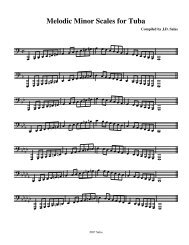
![Finale 2008 - [Chromatic Scales - Tuba.MUS]](https://img.yumpu.com/36500491/1/190x245/finale-2008-chromatic-scales-tubamus.jpg?quality=85)
